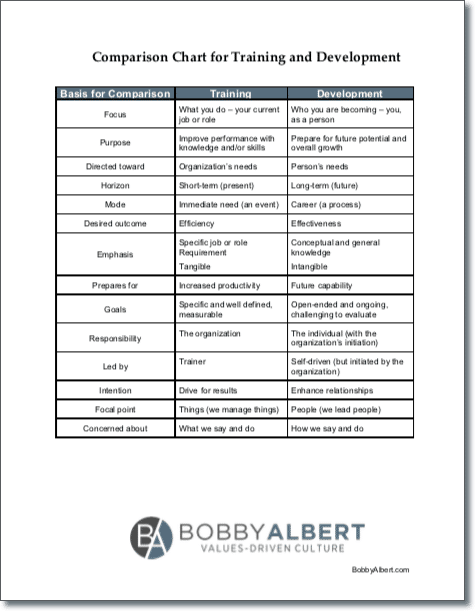Should Leaders Focus on Training or Development?

Some things that happen in life hit you like a tidal wave and my dad's unexpected death was like that for me. The year was 1973. I was 20 years old and a recent university graduate when my dad died. That is when I was thrust to become the new leader of our small family business of five employees.
The second wave of surprise and disbelief hit me when I discovered that our business was carrying a huge amount of debt with very little income!
Survival Mode
Immediately, I was pushed into survival mode – scraping, and scraping, and scraping to just hold the business together. My wife still reminds me that I would give her $20 a week to buy groceries.
I did everything in my ability to improve the efficiency of the organization by reducing expenses and increasing productivity. Initially, I felt I could not do much about increasing the revenue.
Finally, Revenue Increased
Finally, I saw some daylight to increase the revenue. By the end of l974, something amazing happened. With a whole lot of people helping me, we increased revenue by 252%, and we generated the highest profit in the history of the business.
Foreseeing that revenue increase coming, I had to triple the number of employees for our summer peak season. So, I hired mostly students (looking for a full-time summer job) from the local university.
Our New Employees Needed Help
I quickly joined one of my industry's (moving and storage) trade associations who had some excellent packing skills training material that I could use to train our current as well as new employees. This was one way I could help them to become the best employees possible.
I will never forget the phrase used in that training material, which was repeated over and over - "How you ACT is as important as how you PACK." WOW, how true that statement is- even today.
As the years went by and our business kept growing, I continued and expanded into all types of job knowledge and skills training during the non-peak seasons. But I also began to understand that I needed to develop people as well - so that each person could reach their full potential.
Every leader can grow their business by creating a workplace culture that embraces both training AND development.
But, this requires a personal growth plan for yourself and for your people, and it means you need to
Work ON the business while we work IN the business.
- Bobby Albert
When you work ON the business, you intentionally remove yourself and your people from the daily grind of working IN the business. And you set aside time for training AND development.
To be honest with you, in the early years, I did not know there was even a difference between training AND development even though I was doing both.
Over the years, I have observed the words, training AND development as mostly used together in the business world. However, there is a very distinct difference between their meanings and implications, which are often overlooked by most leaders. The downloadable comparison chart (offered below) will help you further understand the differences between training and development.
With change occurring at warp-speed in the business environment, it is crucial that an organization pay equal attention to both training AND development to compete in the marketplace.
Best-selling author Jim Collins, in his book Built to Last, said,
"Instead of being oppressed by the 'Tyranny of the OR,' highly visionary companies liberate themselves with the 'Genius of the AND.' Instead of choosing between A OR B, they figure out a way to have both A AND B."
Collins went on to say that this was not about "balance," in which you go to the midpoint fifty-fifty or half. Instead, highly visionary companies accomplish both at the same time, all the time!
If this is so important, what is the difference between training AND development? Please see the Comparison Chart at the bottom of this article.
Difference Between Training and Development
Now once training has occurred, the organization will expect their employees to practice their newly acquired skills and master them - causing greater revenue, reduced expenses, and increased productivity- therefore adding value to the organization and its customers.
And once development has occurred in the leader and their employees, they are considered as value-added assets to the organization and to its customers.
And, enhancing emotional maturity along with achieving a greater professional edge is what development is all about.
As our company kept growing over the years, I observed that the returns on investment in training AND development to grow myself and to grow our people gave us extraordinary business growth and results. And you can do it as well. Click <here> or on the image below to download my detailed chart defining the differences between training and development.
Are you ready to begin to work ON, not just IN, the business? How do you plan to apply training AND development in your business? Please share your comments <here>. Would someone in your human resource department enjoy reading this article?










